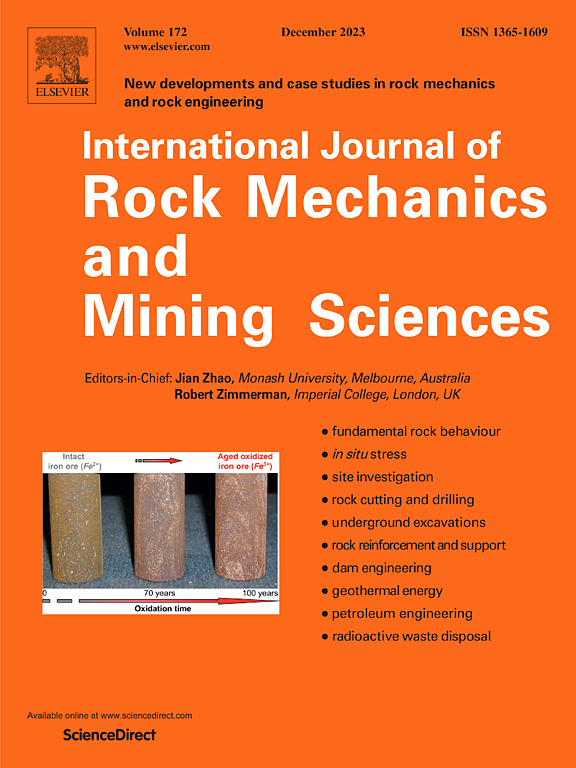Isomerism of using the classic discretization algorithm Z2 for characterizing joint profile morphology roughness and its improvement
IF 7
1区 工程技术
Q1 ENGINEERING, GEOLOGICAL
International Journal of Rock Mechanics and Mining Sciences
Pub Date : 2025-04-08
DOI:10.1016/j.ijrmms.2025.106111
引用次数: 0
Abstract
The discretization algorithm for the root mean square of the first derivative (RMSFD) significantly affects the effective characterization of rock joint profile roughness and the accurate evaluation of the joint roughness coefficient (JRC). The classic discretization algorithm Z2 fails to distinguish morphology roughness differences in isomeric profiles, limiting its characterization capability. To address this, we revisit the original definition of RMSFD and propose an improved algorithm. The discretization scheme for curve profiles in the algorithm is modified. By fully considering the spatial configuration and mutual relationship of the position between adjacent-point microsegments, the forward difference form in Z2 is changed to a central difference form, and another RMSFD discretization algorithm, Zn, is developed. Comparative analysis of RMSFDs for reconstructed profiles using Zn and Z2 demonstrates that the proposed algorithm avoids isomerism and exhibits superior ability in characterizing profile morphology roughness. Furthermore, we establish a functional relationship between Zn and JRC based on retrieved data and validate the superiority of the improved algorithm in characterizing profile morphology roughness. In addition, the capability of Zn on the distinguishing differences of profiles is further confirmed, and the isomerism induced by other indicators is also examined. An anisotropic algorithm and three-dimensional (3D) improved discretization algorithms for the RMSFD are derived. The proposed algorithm Zn is expected to enhance the understanding of morphology characteristics and improve the modeling of roughness for rock joints.
采用经典离散化算法Z2对节理轮廓形貌粗糙度进行异构化表征及其改进
一阶导数均方根(RMSFD)的离散化算法对岩石节理剖面粗糙度的有效表征和节理粗糙度系数(JRC)的准确评定有重要影响。经典的离散化算法Z2无法区分异构体轮廓的形貌粗糙度差异,限制了其表征能力。为了解决这个问题,我们重新审视了RMSFD的原始定义,并提出了一种改进的算法。对算法中曲线轮廓的离散化方案进行了改进。在充分考虑邻接点微段空间形态和位置相互关系的基础上,将Z2中的正向差分形式转化为中心差分形式,并提出了另一种RMSFD离散化算法Zn。通过对Zn和Z2重构轮廓的RMSFDs进行对比分析,表明该算法避免了异构体现象,具有较好的表征轮廓形貌粗糙度的能力。在此基础上建立了Zn与JRC之间的函数关系,验证了改进算法在表征轮廓形貌粗糙度方面的优越性。此外,进一步证实了Zn对不同剖面的区分能力,并对其他指标引起的同分异构体现象进行了探讨。提出了一种各向异性算法和改进的三维离散化算法。提出的算法Zn有望增强对岩石节理形态特征的认识,改进岩石节理粗糙度的建模。
本文章由计算机程序翻译,如有差异,请以英文原文为准。
求助全文
约1分钟内获得全文
求助全文
来源期刊
CiteScore
14.00
自引率
5.60%
发文量
196
审稿时长
18 weeks
期刊介绍:
The International Journal of Rock Mechanics and Mining Sciences focuses on original research, new developments, site measurements, and case studies within the fields of rock mechanics and rock engineering. Serving as an international platform, it showcases high-quality papers addressing rock mechanics and the application of its principles and techniques in mining and civil engineering projects situated on or within rock masses. These projects encompass a wide range, including slopes, open-pit mines, quarries, shafts, tunnels, caverns, underground mines, metro systems, dams, hydro-electric stations, geothermal energy, petroleum engineering, and radioactive waste disposal. The journal welcomes submissions on various topics, with particular interest in theoretical advancements, analytical and numerical methods, rock testing, site investigation, and case studies.

 求助内容:
求助内容: 应助结果提醒方式:
应助结果提醒方式:


